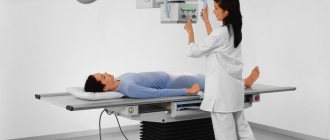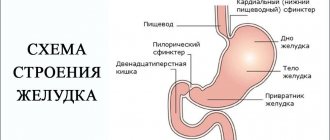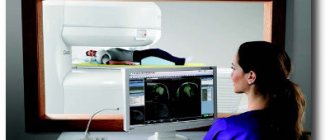Today, x-rays of the stomach are precisely the diagnostic method that is considered the most accurate. Considering the fact that the stomach is a hollow organ, it is best to take an x-ray using a special contrast agent, most often barium sulfate. X-ray with barium makes it possible to timely detect serious diseases that can cost the patient his life. Therefore, everyone should know that any delay in terms of health can be dangerous, which means it is necessary to turn to modern diagnostic methods as soon as possible.
When should barium x-rays be performed?
X-ray scanning of the stomach allows you to obtain accurate images of the organ along with its contours and at the same time check the movement of the substance through the esophagus, that is, the examination is carried out not only of the stomach itself and the entire gastrointestinal tract. Thus, this diagnosis can be prescribed by a specialist in order to confirm or refute the presence of diseases such as:
- Hernia in the stomach area.
- Presence of a stomach ulcer.
- Disturbances in the development of the esophagus and stomach.
- Intestinal obstruction.
- Benign or malignant formations in the gastrointestinal tract.
- Protrusion of the gastric walls.
Due to the fact that barium is used in X-rays, it is possible to freely determine the pathology and even pinpoint the exact location where it is located.
Indications for X-ray examination of the gastrointestinal tract
An X-ray examination of the upper digestive tract is prescribed if the patient has the following symptoms:
- a feeling of heaviness in the abdomen and/or aching pain , which intensifies after a spicy meal or on an empty stomach;
- frequent nausea after eating;
- sharp decrease in appetite;
- the appearance of a bitter or sour taste in the mouth;
- tendency to constipation or diarrhea ;
- pain in the upper abdomen, which intensifies when pressed;
- sensation in the chest or heartburn (occurs mainly after eating);
- the appearance of white plaque on the mucous membranes of the mouth and tongue;
- increased gas formation in the stomach ;
- reducing body weight with unchanged diet and level of physical activity;
- suspicion of a violation of the integrity of the stomach wall.
Help In emergency situations, an X-ray examination of the stomach is performed if it is not possible to do an ultrasound, CT or MRI as soon as possible. This opportunity is used especially often in the surgical department and intensive care unit.
Symptoms that indicate diseases of the stomach and gastrointestinal tract
Of course, a specialist can prescribe an x-ray of the stomach with barium, but the patient himself must clearly understand that at the first symptoms it is necessary to immediately consult a doctor in order to accurately determine what stage the disease is at and provide timely treatment. The following symptoms may be prerequisites for a barium x-ray:
- A person loses weight very quickly.
- There is often a burning sensation in the stomach area.
- Belching occurs for no reason.
- Problems with the swallowing reflex appear.
- There is severe pain in the navel area.
- When defecating, you can see blood clots.
At the slightest manifestation of symptoms, it is recommended to immediately consult a specialist.
What does a fluoroscopy of the stomach show?
X-ray with contrast allows not only to detect the presence of pathological changes in organs in the digestive system, but also to track the dynamics of the development of the disease and the effectiveness of therapy.
What pathologists does an x-ray of the stomach reveal:
- ulcers - contrast is distributed unevenly, fills niches;
- reduction or increase in the volume of the stomach cavity;
- tumors, polyps, or a predisposition to their occurrence;
- deformation or displacement of the walls of organs or the stomach itself relative to other organs - pathology develops with a hernia of the diaphragm or abdominal wall;
- violation of the lumen of the stomach, duodenum - this pathology occurs when a malignant tumor develops inside or outside the organ;
- foci of inflammation.
Fluoroscopy in the Trendelenburg position is performed if a diaphragmatic hernia is suspected.
X-ray helps detect stomach ulcers
How to properly prepare for an examination
Preparation for a barium X-ray of the stomach should be done in advance. If everything is done correctly, you can get high-quality photographs, which is important for further treatment. Doctors recommend being on a special diet for at least two days. You should exclude from your diet foods that contribute to gas formation. You should eat porridge for a while, lean meat, boiled fish and eggs. Prohibited products are:
- Carbonated drinks.
- Cabbage in any form.
- Sweets.
- Milk and any dairy products.
- Buns, bread, pies, cakes.
It is important to note that an X-ray of the stomach with barium is taken on an empty stomach, so a person who is preparing for diagnosis should not eat food either in the evening or on the day of the X-ray itself. It is forbidden to chew gum, smoke or even drink water. According to all rules, the study should be carried out no less than eight hours after the last meal.
There are some cases when patients suffer from a lot of flatulence or severe constipation, in which case doctors recommend that before the study they completely cleanse the body with an enema, and only then will it be possible to perform an X-ray of the intestines with barium.
Before sending a patient for diagnostics, the doctor is obliged to check him for the presence of allergic reactions. Barium sulfate can cause allergies and not all patients are aware that it has a predisposition to allergic reactions. If the allergy is confirmed, then it will be possible to use another contrast substance for the study.
Main stages of preparation
Fluoroscopy of the stomach does not require special preparation. But to get the most truthful result, you should adhere to several rules:
- 2-3 days before the x-ray, you should not take medications other than Espumisan or activated charcoal. These products will help cleanse the gastrointestinal tract of mucus.
- On the day of the examination, smoking and chewing gum are prohibited.
- The subject needs to remove metal jewelry and dentures.
Eating before the examination
The patient is warned that the examination is carried out on an empty stomach. You should not eat food the morning before the diagnosis. You are allowed to drink some water.
Before radiography, the last meal is allowed no later than 7-8 hours before the examination. Before barium fluoroscopy - at least 12 hours before the procedure.
Diet
A diet before undergoing an examination is prescribed to older people.
If the subject does not complain, this is not required. Doctors recommend eliminating heavy, difficult-to-digest foods from your diet .
3 days before the examination, you need to avoid foods that cause increased gas formation.
Nutrition rules
To ensure a clear result, 3 days before undergoing X-ray examinations of the gastrointestinal tract, you need to avoid foods that contribute to increased gas formation:
- all types of cabbage;
- Rye bread;
- legumes;
- potato;
- carbonated drinks;
- fatty, fried foods;
- dairy products;
- baking
It is recommended to eat porridges with water, steamed dishes made from lean meat or fish.
If a patient is hospitalized with a stomach disease, he is prescribed a special diet from the first days of his stay in the hospital. It is important to avoid taking dairy products before the examination.
Preparing for a barium test
When preparing a patient for a barium fluoroscopy of the stomach, the physician should identify the possibility of an allergic reaction. In case of allergies, another contrast agent containing iodine is selected.
A suspension of barium sulfate is not dangerous to health, except in rare cases of individual intolerance. This substance is capable of absorbing radiation without being absorbed into the gastrointestinal tract.
With the help of such a study, a more complete picture of the functioning of the system and clear pictures are obtained.
The patient should adhere to a diet for 3 days before the procedure.
During the examination, the patient is asked to drink two sips of the suspension, and during its passage the walls of the esophagus are examined. Then you need to drink the remaining barium (about a glass), and the radiologist examines the organs and takes pictures.
For patients who are prone to constipation, before undergoing the procedure, it is recommended to cleanse the intestines with an enema before bed and in the morning on the day of the x-ray.
How does the procedure work?
The procedure algorithm is as follows:
- a radiologist examines the organs;
- the patient takes a barium suspension, and the specialist observes the filling of the stomach, the rate of filling and the structure of the mucosa.
The examination takes no more than 40 minutes.
About an hour after administration, barium enters the duodenum, from where it is completely excreted in a short time, and after 1-1.5 hours the stomach is freed from the contrast agent.
The radiologist takes pictures from different positions of the body: lying (on the side, back, stomach) or standing.
Using the Trendelenburg method, a picture of the stomach is taken in a position where the pelvis is elevated at an angle of 35-45 degrees. The doctor asks the patient to hold his breath for a while. This image allows you to determine the presence of a hiatal hernia.
Barium x-ray contraindications
X-ray of the gastrointestinal tract with barium is not recommended in the following cases:
- If the patient is pregnant. It is often contraindicated when a woman is in the early stages of pregnancy. The second and third trimester are more suitable for x-rays, but there must be a really good reason for this.
- The examination cannot be performed if the patient has severe bleeding in the intestines or stomach.
- In case of barium intolerance.
Do not be afraid to take X-rays with barium sulfate if there is a doctor’s indication for this. Such diagnostics are considered painless and allow us to identify the slightest pathologies in the human body.
Preparation for the procedure
Preparation rules take into account the patient's condition. If the functions of the digestive system are not impaired, no special preparation is required. The only condition is that you should not eat for 6-8 hours before the procedure.
If there are digestive dysfunctions, you need a diet:
- Foods whose consumption causes the formation of gases in the intestines are excluded from the diet;
- You can eat lean meat, fresh eggs, fish, and cereals.
- For constipation, the patient is prescribed an enema or gastric lavage.
What does a barium x-ray show?
This diagnostic method allows you to clearly see the location, shape and diameter of the lumen in the intestine, find out the degree of its elasticity and find out how much the tissue can stretch. The doctor evaluates the appearance of the organ and checks individual intestinal functions. X-ray with barium allows you to see in time the obstruction of the intestine, the anomalies that occur in it, for example, all this can be caused by polyps, diverticula and tumors.
Such a diagnosis will not cause any harm to health, since no mechanical impact is applied to the body and it will not be possible to injure the lining of the stomach or intestines. Barium sulfate is not absorbed into the blood and allows you to get clear photographs on the monitor, which are then examined by a specialist.
How is diagnostics done with barium sulfate?
In order not to be afraid of this type of research, you should definitely learn in detail how X-rays are done with barium and how much it can negatively affect the human body. During the diagnosis, the patient will have to remove all metal jewelry. Before proceeding to the examination itself, the doctor gives the patient a substance to drink, which is barium sulfate.
After this, the patient will need to be placed on the couch and the examination will begin. Many people are interested in when an X-ray of the esophagus with barium is taken, what does the monitor show? It should be noted that the doctor sees everything down to the smallest detail. The specialist monitors exactly how the walls of the mucous membranes and digestive organs are washed and observes the activity of the esophagus.
During the diagnosis, the patient will need to drink additional barium sulfate so that the stomach can fill tightly. The doctor himself will be able to guide the patient and tell him how he should change his body position. For example, the patient will be able to lie on his side, stomach, the examination can be carried out lying on his back, or even in some cases stand on his feet. A pose often used is when a person lies on his back with his pelvis raised. The procedure itself does not take much time; it will be completed in forty minutes.
Features of X-ray with barium
Often, for diagnostic accuracy, not only barium sulfate is used, but double contrast is also performed. The mixture for this is prepared exclusively before the diagnosis itself; it consists of 650 grams of barium sulfate, which dissolves in warm water, and almagel, which makes the solution viscous. Additionally, sorbitol, an antifoam agent, and sodium citrate can be added to the product. In order for the doctor to get a complete picture, he needs to take six pictures.
What could be the consequences of such a diagnosis?
When asked how dangerous is an X-ray of the stomach with barium, the consequences of such a study, one can answer that, be that as it may, it is a small amount of radiation. Therefore, it is recommended to undergo such a study no more than once a year.
As soon as the procedure itself is completed, the patient may at most experience slight nausea, which goes away within an hour. Barium sulfate is easily excreted from the body; it comes out along with the stool, which will be colored white, so there is no need to worry about this. Patients may expect constipation for a while, but this is due to the binding effect of barium sulfate. To get it out of the body as quickly as possible, you should drink two liters of water.
Technique
2 hours before the start of the study, the intestines are cleansed, since an X-ray examination of the stomach is carried out with an examination of the intestines the next day. Then the patient is given a special enveloping solution to drink, which includes barium sulfate. It plays the role of a contrast agent. It is recommended to remove all jewelry that may distort the picture.
The patient is examined in three positions: standing, lying down and the Trendelenburg position (pelvic elevation by 450). The doctor takes a series of pictures in different projections. In order for the contrast solution to be evenly distributed, the doctor performs a small massage in the abdominal area.
Sometimes a procedure may be prescribed using a double contrast solution, which includes barium, almagel, sorbitol, sodium citrate, carboxymethylcellulose and ethanol. The patient drinks it through a special straw.
It is important to note that during this procedure the patient is heavily exposed to radiation, so it is not recommended to undergo it more than once a year.
Diagnostic results using barium sulfate
X-ray with barium makes it possible to obtain accurate results about the human organs that are inside. At different stages, many pathologies can be identified at once. The doctor will be able to take pictures that will help to fully examine the structure of the stomach and the relief of the esophagus.
When photographs are taken from the side or from an oblique projection, it will be possible to evaluate the relief of the antrum and reflux of the esophagus. When a picture is taken with the pelvis raised, the specialist will be able to carefully examine the condition of the fibers and examine the opening of the diaphragm. When pictures are taken of the back area, the elasticity of the tissue can be checked.
An X-ray of the intestines with barium allows you to immediately see all the changes that may indicate that there are some pathologies in the body. The specialist will be able to announce the diagnostic results a maximum of two hours after the examination. If the pathology cannot be seen immediately, it may take more time to process the results, but usually no more than a day.
As you can see, there is nothing wrong with an X-ray using barium sulfate, and the patient will not experience any discomfort that may occur when gastroendoscopy is performed, and the effectiveness of this method is also several times higher.
You should not risk your health and life, because many diseases are best identified and treated in the early stages.










